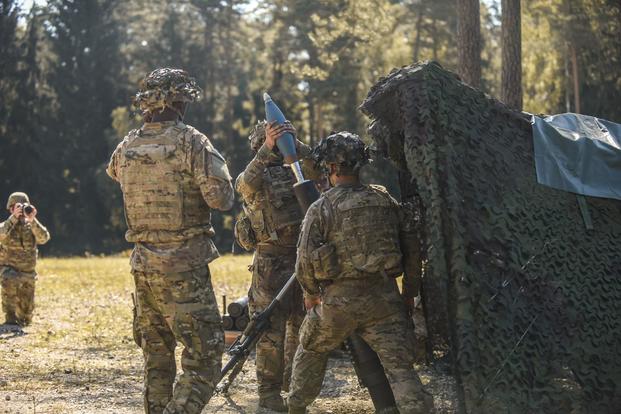The U.S. Army wants to replace its current mounted and towed 120mm mortars with new systems that will shoot farther and offer protection for mounted crews.
Army officials from Product Manager Precision Fires and Mortars and Project Manager Combat Ammunition Systems began market surveys in August to find defense firms capable of producing a 120mm Mortar Future Indirect Fire Turret by 2021 and a 120mm Extended Range Mortar system by 2026, according to two Aug. 2 solicitations.
The new 120mm Mortar Future Indirect Fire Turret, or FIFT, "is a 120mm turret that provides protection from enemy counter battery systems and insulates soldiers from the effects of both noise and blast overpressure," the FIFT solicitation states. "This turret shall be capable of firing heavier projectiles at a greater range than the current Battalion Mortar System (BMS) or Recoil Mortar System-Light (RMS-L)."
As an objective requirement, the Army wants the new turret system to shoot out to 20,000 meters, or 12.4 miles, according to the FIFT solicitation.
Both the Army and the Marine Corps have expressed interest in mortar systems that shoot farther. Earlier this year, the Corps began searching for a company capable of producing the Advanced Capability Extended Range Mortar, or ACERM -- a mortar round compatible with existing Marine and Army M252 81mm mortar systems that offers an effective range of up to 20,000 meters as well.
Military.com asked the Army for an interview on the subject, but the service did not provide a subject matter expert by deadline.
The Army also wants the FIFT to have more automation so the "physical burden on crew is reduced, while supporting a high rate-of-fire capability," according to the solicitation. In loading and firing, the Army wants a system where "ammo transitions from stowage through the firing event without human contact."
At a minimum, the system should have a maximum rate of fire, or MROF, of 16 rounds per minute for one minute followed by a sustained rate of fire, or SROF, of 6 rounds per minute "indefinitely," the solicitation states. Ideally, the Army wants a system capable of "being fired at the MROF of 24 rounds per minute for 2 minutes and maintain a SROF of 12 rounds per minute indefinitely."
The FIFT may be manned or unmanned and designed to be compatible with the Stryker, Armored Multi-Purpose Vehicle, and Next-Generation Combat Vehicle.
The Extended Range Mortar, or ERM, would be designed to shoot significantly farther than the 7,240 meter range of the current M120A1 towed mortar system it would replace.
"The system range must be sufficient to address targets at 9 km [or 9,000 meters]," the ERM solicitation states. "The 120mm ERM shall provide responsive, accurate long-range fire with the assistance of digital fire control similar to the M150 Mortar Fire Control System -- Dismounted."
Despite its extended range, the Army's ERM may be heavier than the current M120A1, which weighs 319 pounds for a crew of five soldiers. The ERM "shall not exceed 400 pounds for a threshold requirement," the solicitation states. "The system must be man portable by the squad, with each member of the 4 man squad having a weight allocation of roughly 100lbs of this kit."
The ERM must also "limit blast effects and crew exposure to overpressure to acceptable limits in order to support the firing of up to 100 rounds per day," the solicitation states.
-- Matthew Cox can be reached at matthew.cox@military.com.










